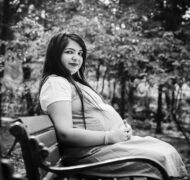Pregnancy
Book / Produced by partner of TOW
Once conception has occurred, a human life miraculously unfolds in the nurturing womb, inspiring the scriptural metaphor of pregnancy as “fruitful waiting.” The mother’s experiences are as diverse as seasonal changes as she marks time in contemplation, preparation, prayer and hope. Intrauterine life is celebrated in Psalm 139 and Eccles. 11:5, confirming God’s faithful presence as we are “fearfully and wonderfully made.” It is a mysterious journey, marked by growth and development not only for mother and child but for the entire family, as love expands to embrace a new member.
A Mother’s Seasonal Expectations
Invested with an inner garden, a pregnant woman becomes the object of processes beyond her control in a way not unlike the seasonal changes a gardener observes. Scripture reassures us of God’s plan, purpose and hope for the future (Psalm 104:19; Jeremiah 29:11; Isaiah 43:1-2). The child’s presence is signaled by detectable hormonal and physical changes from the very start of the pregnancy. In autumn the excitement of the news is heralded by a brilliant arboreal display of colors and meteors that fall earthward—fireworks from heaven. As light lessens and the fog rolls in off the sea, there may be a seasonal clouding of volition and certainty held just weeks before. Perhaps even the wisdom of the decision to become pregnant may be doubted as nausea and fatigue obscure joy, calling into question the energy and ability to become a responsible and loving parent. Tearfulness mists or rains in torrential bursts of emotion. Concentration is fragmented by anxiety, and distraction makes everyday tasks more burdensome. Nausea and hypersensitive taste and smell confer vigilance in avoiding exposing the vulnerable embryo to possible toxins. As trees release their leaves, so is relinquishing essential for this season of preparation. The woman yields the constancy of her body shape to metamorphosis and surrenders her independence as she considers how her activities and decisions will affect the child she carries within. If it is a first pregnancy, forever altered is the exclusivity of being “just us two.” This is a time to plant bulbs of hope deep beyond the reach of the threat of frost’s fingers (see Miscarriage).
The clear winter days afford a heightened scrutiny of people that before had escaped her notice—pregnant and nursing mothers, children in fathers’ arms. Anticipating new responsibilities, values and priorities, and changes in identity demands tremendous effort and time. Burying herself in quiet seclusion, the woman nourishes roots, reconnecting with her concept of family by reliving childhood memories. She may retreat to reading and inner places of imagining and prayer (Romans 12:12). The days are short and the nights are long. This hibernation is essential for many creatures in winter, who conserve their resources by resting until spring’s awakening.
Midway through pregnancy subtlety and secrecy give way to the visibly expanding cradle of the womb. Now undeniable, the pregnancy becomes publicly anticipated. Anchored no longer in her monthly menstrual cycle (see Menstruation), she finds new identity as a mother-to-be. She is the object of others’ encouragement and advice, sometimes conflicting and excessive (Mary and Elizabeth share their pregnancies in Luke 1). How often do strangers smile and with overly eager hands stretch out reflexively to sense this new life! Like spring stirring beneath the ground, the baby’s movements become distinguishable from internal intestinal sensations. The tangible relationship of a mother and child begins when she notices her baby’s pattern of activity and responses to her changing positions and shared sounds of music and voices. Fathers and siblings finally become participants, appreciating the baby’s vitality by touch or sharing the visual images of the ultrasound that delineates the fetus’ form and movement.
Summer ripens in a plethora of glow and sweat. With heavy abundance she is a tree laden with fruit and swollen breasts. She chronicles long days and short nights with insomnia arising from mild discomforts or the sheer elation of the imminent harvest. This change is more bearable when considered a conditioning preparation for the sleep deprivation and altered rhythms that inevitably accompany the birth of baby. “I actually remember feeling delight at 2:00 in the morning when the baby woke for his feed, because I so longed to have another look at him” (Margaret Drabble, in Ward, p. 13).
The Fetal Dance
Complete at conception, within the fertilized ovum are the DNA designs whose secrets will be elaborated in this mysterious “becoming” that persists well beyond birth—in fact until death. A genetically unique individual, the human embryo passes through sequential transformations, beginning as a single primordial cell that reenacts the evolutionary story of the entire species. Cells divide, migrate, polarize and specialize, becoming organs, cartilage and bone. Only two weeks after the first missed menstrual period, a primitive tubal heart is already beating in an embryo the size of a small bean. Common to fish eggs and the mammalian embryo is a yoke sac, a source of nourishment; in the human embryo it provides blood cells until bone marrow forms and it is no longer needed. Also vestigial, the embryo’s tail disappears.
As the fetal brain cells develop, we are reminded of God’s prompting to evolve life towards greater and greater awareness of self and Maker. The Creator pushed beyond the probability of statistics to place consciousness on this cooling crust of earth. “He has set eternity in the hearts of men; yet they cannot fathom what God has done from beginning to end” (Eccles. 3:11). By birth, all of the 100 billion brain cells of adult life are present, although the labyrinthine connections are woven throughout early life and are influenced by experience and inhibited by alcohol. This loom’s complexity is elaborated by the fact that each cell may ultimately communicate with between one thousand and ten thousand other cells through sixty different chemical messengers (neurotransmitters). The total number of possible interactions exceeds the number of particles in the universe. The human brain is the most highly organized structure known! There is no lack of stimulation in the womb and the hard wiring begins long before birth.
Consider the evolving awareness of the fetus swimming in a warm intrauterine sea. Our blood is the sea continued in our veins—we are the fruits of the ocean born to walk on the land. As surf pounds rhythmically against the shore, so the earliest perception of sounds from the fourth month in pregnancy is the primitive drum of our mother’s heart. Unlike a swimmer who dives down from the surface, trapping a muffling air cushion in the auditory canal, the fetus experiences amplified sounds when transmitted uninterrupted through water to the eardrum. The womb is anything but quiet. Externally we share the sound world, and internally the fetus hears profound bowel gurgling and the rhythmic surging of placental blood to its own quicker-paced heartbeat superimposed on the slower maternal base beat.
From a hand-clapping, feet-marching rhythm echoed in our earliest perceptions comes the primal response of dance. Children sing before they speak and sway before they walk, interpreting and synchronizing themselves with the rhythms of human pulsations. Dance has been historically the earliest outlet for emotion, at the dawn of rituals and the arts, giving the inarticulate a voice as a personal form of prayer (“a time to dance,” Eccles. 3:4). John the Baptist “leaped for joy” in the womb at Mary’s arrival (Luke 1:44). The lively movements of the fetus are visible on ultrasound as early as ten weeks from the last missed period—months before they are perceptible by the mother or an outside hand. Consider the modern wonder of the ultrasound images that elaborate a beating heart, a delicate profile, a thumb being sucked and the Doppler-amplified heart sounds that reverberate through the doctor’s examining room. These are among the technological changes that have enhanced bonding and allayed anxiety.
The sensuous world of the fetus consists of the tactile embrace of the womb, the response of the mother’s pat to the place of a kick, positional changes in the inner ear as tiny stones falling with gravity stimulate hair cells in one of three directional canals translating “up,” “down” and “side to side.” There is uniformity in the protective amniotic bath, with constant satiety, warmth and darkness or a reddish glow. It is a safe, sterile and buoyant place to practice the primal skills of sucking, grasping, clinging and dancing. It is this focused, rhythmic environment of our prememory existence that we try as adults to re-create through meditation, chants or even jogging. Medicine increasingly acknowledges that the relaxation response appears essential for health and coping with illnesses, pain or stress. By imagining her child’s intrauterine experience, the expectant mother practices relaxation and rhythmic, controlled breathing, so preparing herself for the trials of labor (see Birth).
Cocreators with Each Other and God
As creation unfolds within the expectant mother at the instigation of the awaiting father, they acknowledge that the child is not formed by their own concepts. They have worked but cannot take credit, they are creating but not possessing. Pregnancy’s task is to begin to relinquish our hold on the individual within, whose love, respect and obedience are engendered beyond parental control. Our child’s destiny, although of utmost concern, is not entirely in our hands. We stand parallel, shoulder to shoulder before our Maker, neither slave nor master, king nor pawn.
As the child begins so near to the heart of the mother, it is understandable that in contemplating birth she anticipates a rending that is lifelong, a vulnerability to hurt and be hurt. We are inevitably imperfect parents in the forgiving arms of our heavenly Father. Even into the womb we glimpse our humanity. Amniotic fluid is the brine of sweat and tears, secreted around the developing fetus, welling up from the deepest recesses of joy, sorrow and toil, a salient harbinger of the inherent suffering that our connectedness entails as being parent and child. The baptismal tides of confession and forgiveness can cleanse and preserve the vitality of unconditional love within the family and our identity and hope as children of God, sowing in tears and reaping with shouts of joy (see Psalm 126:5). We are all pregnantly awaiting ultimate healing and reconciliation in the new heaven and the new earth; each season is weathered in faith and trust that God will be faithful to his promises.
» See also: Conception
» See also: Birth
» See also: Breast-Feeding
References and Resources
F. G. Bushe, “When in This State: The Relaxation Response,” Wellness 2, no. 5 (November/December 1992) 28-33; C. DeMarco, Take Charge of Your Body (Winlaw, B.C.: The Well Woman, 1994); L. Nilsson, A Child Is Born (New York: Dell, 1993); C. J. Shatze, “The Developing Brain,” Scientific American, September 19, 1992, 60-67; J. M. Ward, Motherhood, a Gift of Love (Hong Kong: Running Press, 1991).
—Carol Anderson





